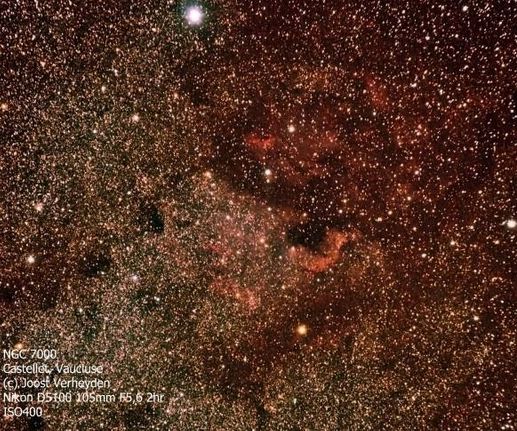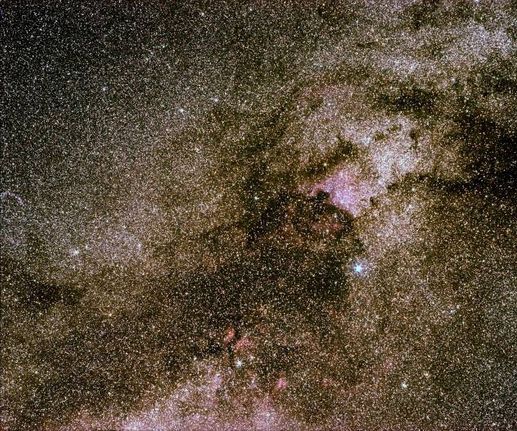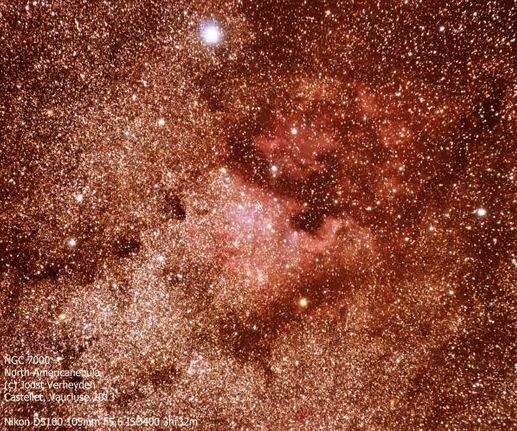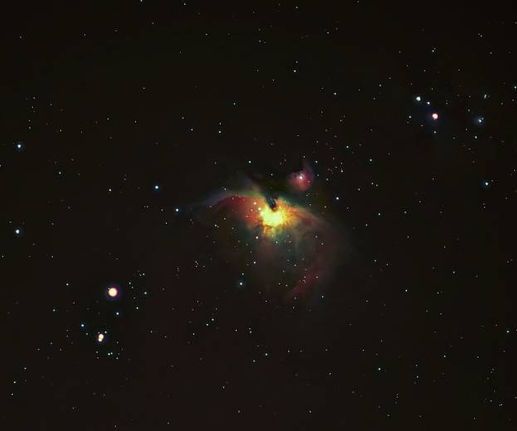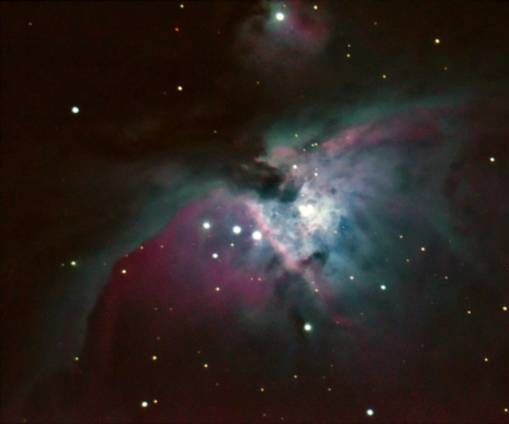Drogenberg
Astrophotography
(c) Joost Verheyden
Hoegaarden, Belgium
2016, December 4 Added frames of 600 seconds to the previous session of this object, and then selected the 14 best frames to stack. In total 140 minutes or 2 hours 20 minutes integration time.
2016, October 4th. First light for the IR modified Nikon D750 In total 4hrs and 15mins of 300s subs at 800 ISO. Nikkor ED F2.8 180mm @ F5.6 and external 48mm IDAS LPS D1
SQM Value around 20,45
2016, September 9th taken in Meldert, Hoegaarden. Since a number of weeks two streetlights around my home are broken. The effect is very noticeable: perfectly dark at night, what a relieve! Also the best spots for observing in the garden can now be used. Perfect. SQM was 20,45
For this picture I used a new technique which is OAG or Off Axis Guiding. FOr me it's new. And the first result is already marvellous. Perfect guiding of the stars. I used an old C11 with an old Nikon D5100 (Unmodified), a Starizona LF SCT Corrector/Reducer resulting in a focus of 2010mm @ F7.2 ; also an IDAS LPF D1 was used as the TS OAG 9mm with a Nikon adapter. 5x300S and 11x600seconds on ISO800. The guider was the Lacerta MGEN. It was rather difficult to find a guidestar, later I discovered I placed the IDAS before the guider, which takes away light. Next time it will move to the back. In fact, I tried to image NGC6888 after this shot and did not succeed in finding a suitable guidestar.
Processing was done by myself this time using Photoshop.
2016, August Castellet: Sadr Region in Cygnus. 135mm Nikkor @F4 and 15minute exposures unguided on HEQ5. Clip-in Optolong CLS

July 2016
NGC7000 the very famous North-America nebula. Nikon D750 ISO800 11x300s with IDAS LPS D1 and the TS65APO-Q on a HEQ5 with Lacerate Autoguider. This picture was taken with a 50% moon in the sky !!! Also, be aware no H-Alfa filtering was applied, this camera is not modified either. "Natural colors" SQM was around 19 till the moon reached the horizon then it dropped to 20,56. Unfortunately also clouds drifted in and I had to switch to darks. There is a small satellite trail which is kind of cute. This image was resized 50%, the TS65APO shows considerable distortion in the corners of a full-frame. The connections with the camera were all threaded.

July 3th 2016 It has been raining and cloudy for two months! it's difficult to move forward using new equipment, as time lacks to experiment and fine tune the setup.
I got a new opportunity between clouds passing over but with a very clear sky SQM 20,52 (even in these grey summer solstice nights). The result below is the well-known planetary M27 in Vulpecula, the little fox. Called also the "Dumbell Nebula" it's at a distance of 1360 light years and discovered by Charles Messier in 1764. The nebula is the result of the central star (a white dwarf) pushing out gas layers. The size of this object is 8 arc minutes. The picture was taken with the C11 Starizona LF SCT Corrector F7.2 and the Nikon D750 FUll Frame. M68 Zeiss extension tubes with an M48 Nikon adapter, embedding an IDAS LPS D1 filter. Total imaging time about 50 minutes @ ISO 800. Below picture is zommed in a little bit. Credit to Jean Lammertyn for final image editing in PixInsight.
Rosetta nebula December 10th 2015
TS 65mm F6.5 APO and the Unmodded (TrueColor) Nikon D5100. 4hrs15m of data in 5 minute frames.

2015 September Hoegaarden NGC 6960
this is the magnificent "Veil nebula" in the constellation Cygnus.
It's remnants of a star thas has blown away it's outer gas shells, now we can witness the beautiful lace-like filaments across a milky way background filled with thusands of stars. The colors of this nebula are alwys a challenge.
This was captured using the TS65APO-Q with the Unmodified Nikon D5100,hence true colors.
A total of 4 hours of data captured during the night of September 20th, 2015 Hoegaarden

2015 September Hoegaarden IC1396 Cepheus
This is a very large Hydrogen-Alpha gas nebula about a dozen moon diameters in apparent size. The 180mm Nikkor was used with a frontal diafragma using the 48mm IDAS LPS D1 filter. About three hours of 5-minute frames on ISO800. SQM 20,35

2015 September Hoegaarden M16 & M17 The Eagle & Sawn nebula in Serpens and Sagittarius
Both nebula fit in the view of the TS65APO telescope using the Nikon. Due to it's low altitude above the horizon, there was only 1 hour of 5-minute frames on ISO 800 possible before it disappeared behind the trees.

2015 August Castellet, Vaucluse The Helix nebula NGC 7293
I was planning on taking some more pictures in Castellet, however my HEQ5 mount broke down after only 1 partial night of imaging. So thi sis the result, an half hour of 5-minute frames using the TS65APOQ. This picture is a crop of the original.

2015 June 10 M57 or Ring Nebula in Lyra. Also a small galaxy is visible, of which the distance is about 221 Million Lightyears. The nebula M57 lies within or own galaxy and is only 2300 lightyears away. C11 at F10, 1hr21m at ISO800 Nikon Unmod D5100 NEQ6

2014 November IC1396 or the large nebula in Cepheus which contains the 'Elephant Trunc' nebula. Picture with the 135mm Nikkor unguided on the HEQ5 from Grandpré, France. SQM 21,40. Processing: J. Lammertyn This southern region of Cepheus contains complex Milky Way structures with H-Alfa emmision, open star clusters and simply a lot of stars. The picture contains the large nebula IC1396 and lots of dark nebula (Barnard designation). On the lower right the purple Sharpless nebula.
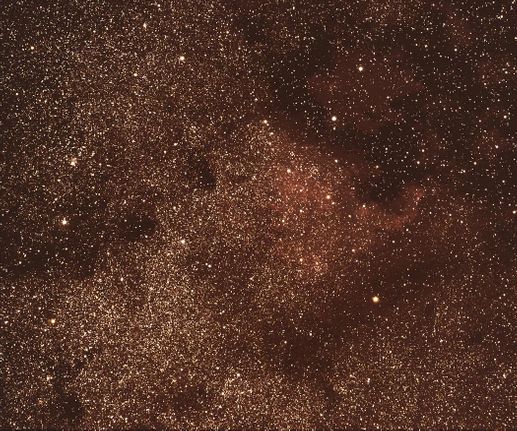
2014 July 30th NGC7000 with the 180mm F2.8 Nikkor without IDAS filter. The difference with the next image is very obvious: much less contrast without the filter
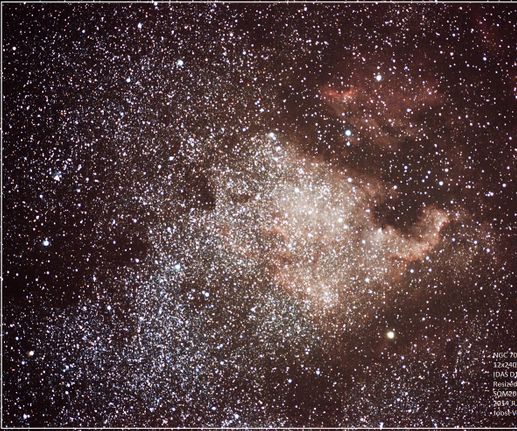
2014 July 24th NGC7000 with a 200mm F4 Nikkor and the IDAS D1 filter
A very pleasant night with high temperatures 22 °C which is good for me but bad for noise. So I decided to image on ISO400. The North-Americanebula and the Pelican Nebula fit nicely into the frame of the old vintage 70-ties 200mm F/4 Nikkor. Because it is fairly scharp at the edges I did not stop it down any further. The IDAS D1 light pollution filter was screwed on top of the lens with a reduction ring 52mm to 48mm. This resulted in a little bit of vignetting.
I left the old HEQ5 unguided doing it's work, and actually should have done a better job either by guiding either by polar aignment. I lost several frames for which the scharpness was not ok.
Basically I'm pleased with the result as the H-Alfa comes out pretty well for an unmodified sensor (Nikon D5100). It also demonstrates that acceptable results do not need an SQM 21+sky . This was a foggy summer night in Hoegaarden with SQM 20,30 at zenit.
Picture published in Guidestar magazine August 2014

2014 Plejades or M45. The blue reflection nebula is clearly visible most prominent around Merope. Comparing this picture with the one from one year ago (see below Nov 11), made with the same setup but less integration time. I reworked this version after improving my processing skills in January 2015
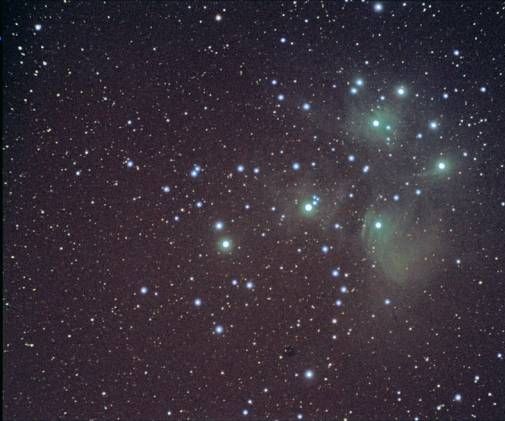
2013 November
The Plejades with the 90mm Robtics Achromat from Hubert Hautecler (Boutersem) and D5100
(c) Copyright 2014 Some Rights Reserved: Attribution-NonCommercial-NoDerivs. To use any of these pictures commercially contact: pictures(at)drogenberg.be or use the contact form.







